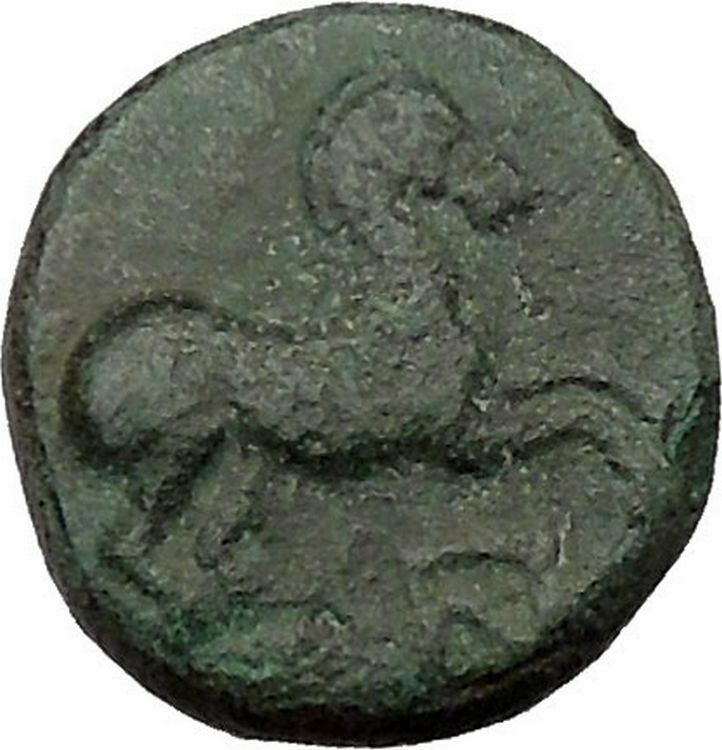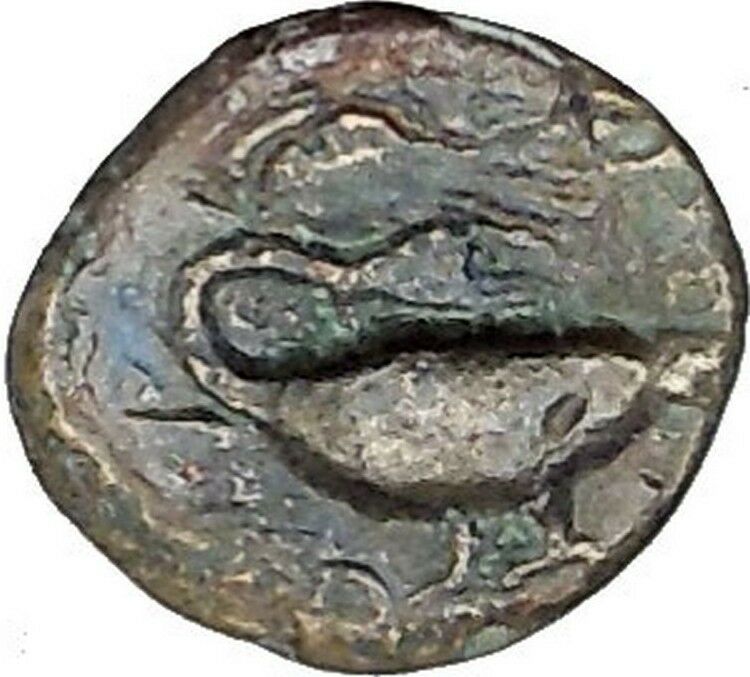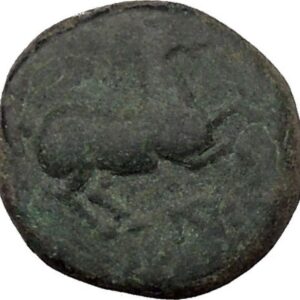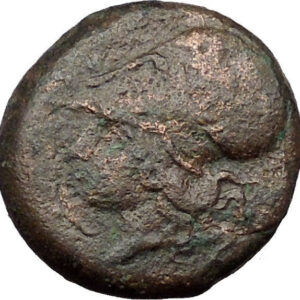|
Greek city of
Permanon in
Mysia
Bronze 23mm (5.00 grams) Struck circa 150-50 B.C.
Reference: Sear 3960; B.M.C. 15. 112,22-3
Head of Athena right, in crested Corinthian helmet.
AΘΗΝΑΣ / ΝΙΚΗΦΟΡΟΥ either side of trophy.
Situated in the Kaikos valley, about 15 miles from the
coast, Pergamon was a city of uncertain origin and of no great importance before
the time of Alexander the Great. In the 3rd century B.C. it became the center of
the independent kingdom ruled by the Attalid dynasty founded by Philetairos. The
city was extended and beautified as the prosperity of the kingdom increased, and
by the late Hellenistic times Pergamon ranked as one of the great cultural
centers of the Greek world. After the end of the kingdom, 133 B.C., Pergamon
became capital of the Roman province of Asia.
You are bidding on the exact item pictured,
provided with a Certificate of Authenticity and Lifetime Guarantee of
Authenticity.

Athena
or Athene (Latin:
Minerva
),
also referred to as Pallas Athena, is the goddess of war, civilization,
wisdom, strength, strategy, crafts, justice and skill in
Greek mythology
.
Minerva
,
Athena’s Roman incarnation, embodies similar attributes. Athena is also a shrewd
companion of heroes
and the goddess
of heroic
endeavour. She is the
virgin
patron of Athens
.
The Athenians built the
Parthenon
on the Acropolis of her namesake city, Athens, in her honour (Athena Parthenos).
Athena’s cult as the patron of Athens seems to have existed from the earliest
times and was so persistent that archaic myths about her were recast to adapt to
cultural changes. In her role as a protector of the city (polis),
many people throughout the Greek world worshiped Athena as Athena Polias
(“Athena of the city”).
Athens
and Athena bear etymologically connected names.
A trophy is a reward for a specific achievement, and serves as
recognition or evidence of merit.
A tropaion (Greek:
τρόπαιον,
Latin
:
tropaeum), whence English “trophy”
is an ancient Greek
and later
Roman
monument set up to commemorate a victory
over one’s foes. Typically this takes the shape of a tree, sometimes with a pair
of arm-like branches (or, in later times, a pair of stakes set crosswise) upon
which is hung the armour
of a defeated and dead foe. The
tropaion is then dedicated to a
god
in thanksgiving for the victory.

A Roman tropaeum from the
Dacian Wars
(Trajan’s
Column 113 CE, note the tree trunk with arm-like
branches)
Greece
In the Greek city-states
of the
Archaic
period, the tropaion would be
set up on the battlefield itself, usually at the site of the “turning point”
(Gk. tropê) at which the routed enemy’s
phalanx
broke, turned and ran. It would be
dressed in the typical
hoplite
panoply
of the period, including (at different
times), a
helmet
,
cuirass
(either of
bronze
or
linen
), and a number of
shields
,etc, would be piled about the base. It
remained on the battlefield until the following season’s campaigns (since
battles were often fought in the same, relatively few plains amid Greece’s
numerous mountains), where it might be replaced with a new trophy.
In later eras in the Greek world, these tropaia might be vowed at the
battle-site, but in fact erected at
pan-Hellenic
sanctuaries such as
Olympia
or
Delphi
to further increase the prestige of the
victorious state.
The significance of the monument is a ritualistic notification of “victory”
to the defeated enemies. Since warfare in the Greek world was largely a
ritualistic affair in the archaic hoplite-age (see
Hanson
, The Western Way of War for
further elaboration of this idea), the monument is used to reinforce the
symbolic capital
of the victory in the Greek
community.
Ancient sources attest to the great deal of significance that early Greek
cities placed upon symbols and ritual as linked to warfare–the story involving
the bones of Orestes
, for example, in
Herodotus
1 which go beyond the ritualistic
properties to even magically ‘guaranteeing’ the
Spartan
victory, displays the same sort of
interest in objects and symbols of power as they relate to military success or
failure.
Rome
The tropaeum in Rome, on the other hand, would probably not be
set up on the battle-site itself, but rather displayed prominently in the city
of Rome. Romans were less concerned about impressing foreign powers or military
rivals than they were in using military success to further their own
political careers
inside the city, especially
during the later years of the
Republic
. A tropaeum displayed on the
battlefield does not win votes, but one brought back and displayed as part of a
triumph
can impress the citizens (who might
then vote in future elections in favor of the conqueror) or the nobles (with
whom most aristocratic Romans of the Republican period were in a constant
struggle for prestige).
The symbolism of the tropaeum became so well known that in later eras,
Romans began to simply display images of them upon sculpted reliefs (see image
and
Tropaeum Traiani
), to leave a permanent trace
of the victory in question rather than the temporary monument of the tropaeum
itself.
Originally the word trophy, derived from the Latin
tropaion
, referred to arms, standards,
other property, or human captives and body parts (e.g.
headhunting
) captured in battle. These
war trophies
commemorated the military
victories of a state, army or individual combatant. In modern warfare trophy
taking is discouraged, but this sense of the word is reflected in
hunting trophies
and
human trophy collecting
by
serial killers
.
Trophies have marked victories since ancient times. The word trophy
coined in English in 1550, was derived from the French trophée in 1513,
“a prize of war”, from Old French trophee, from Latin trophaeum,
monument to victory, variant of tropaeum, which in turn is the
latinisation
of the
Greek
τρόπαιον (tropaion),
the neuter of τροπαῖος (tropaios), “of defeat” or “for defeat”, but
generally “of a turning” or “of a change”, from τροπή (tropē), “a turn, a
change” and that from the verb τρέπω (trepo), “to turn, to alter”.
In ancient Greece, trophies were made on the battlefields of victorious
battles, from captured arms and standards, and were hung upon a tree or a large
stake made to resemble a warrior. Often, these ancient trophies were inscribed
with a story of the battle and were dedicated to various gods. Trophies made
about naval victories sometimes consisted of entire ships (or what remained of
them) laid out on the beach. To destroy a trophy was considered a sacrilege.
The ancient Romans kept their trophies closer to home. The Romans built
magnificent trophies in Rome, including columns and arches atop a foundation.
Most of the stone trophies that once adorned huge stone memorials in Rome have
been long since stolen.
Pergamon, Pergamum or Pérgamo (in
Greek
, Πέργαμος) was an ancient
Greek
city in modern-day
Turkey
, in
Mysia
, today
located 16 miles (26 km) from the
Aegean Sea
on a promontory
on the north side of the river
Caicus
(modern day
Bakırçay
),
that became the capital of the
Kingdom of Pergamon
during the
Hellenistic period
, under the
Attalid dynasty
, 281–133 BC. Today, the main sites of ancient Pergamon are
to the north and west of the modern city of
Bergama
.
//
History

The
Kingdom of Pergamon
(colored olive), shown at its
greatest extent in
188 BC
The
Attalid
kingdom was the
rump state
left after the collapse of the
Kingdom of Thrace
.
The Attalids, the descendants of Attalus, father of
Philetaerus
who came to power in 281 BC following the collapse of the
Kingdom of Thrace, were among the most loyal supporters of
Rome
in the Hellenistic world. Under
Attalus I
(241-197 BC), they allied with Rome against
Philip V of Macedon
, during the
first
and
second
Macedonian Wars
, and again under
Eumenes II
(197-158 BC), against
Perseus of Macedon
, during the
Third Macedonian War
. For support against the
Seleucids
, the
Attalids
were rewarded with all the former Seleucid domains in
Asia Minor
.
The Attalids ruled with intelligence and generosity. Many documents survive
showing how the Attalids would support the growth of towns through sending in
skilled artisans and by remitting taxes. They allowed the Greek cities in their
domains to maintain nominal independence. They sent gifts to Greek cultural
sites like Delphi
,
Delos
, and
Athens
. They
defeated the invading Celts
. They remodeled the
Acropolis of Pergamo
after the
Acropolis
in Athens. When
Attalus III
(138-133 BC) died without an heir in 133 BC he bequeathed the
whole of Pergamon to Rome, in order to prevent a civil war.
According to Christian tradition, the first bishop of Pergamon,
Antipas
, was martyred there in ca. 92 AD. (Revelation
2:13)
The
Ottoman
Sultan
Murad III
had two large alabaster
urns transported from the ruins of Pergamon and placed on two
sides of the nave in the
Hagia
Sophia
in Istanbul
.
Notable
structures
Upper
Acropolis

The Great Altar of Pergamon, on display in the
Pergamonmuseum
in
Berlin
,
Germany

Model of the Acropolis in the Pergamonmuseum in Berlin
The
Great Altar of Pergamon
is in the
Pergamon Museum
, Berlin. The base of this altar remains on the upper part of
the Acropolis. It was perhaps to this altar, believed dedicated to Zeus, that
John of Patmos referred to as “Satan’s Throne” in his Book of Revelation
(Revelation 2:12-13).
Other notable structures still in existence on the upper part of the
Acropolis include:
Pergamon’s library on the Acropolis (the ancient
Library of Pergamum
) is the second best in the ancient Greek civilization.[4]
When the
Ptolemies
stopped exporting
papyrus
,
partly because of competitors and partly because of shortages, the Pergamenes
invented a new substance to use in
codices
, called
pergaminus or pergamena (parchment)
after the city. This was made of fine
calfskin
, a
predecessor of
vellum
. The library at Pergamom was believed to contain 200,000 volumes,
which Mark Antony
later gave to
Cleopatra
as a wedding present.
Lower
Acropolis
The lower part of the Acropolis has the following structures:
- the Upper Gymnasium
- the Middle Gymnasium
- the Lower Gymnasium
- the Temple of
Demeter
- the Sanctuary of
Hera
- the House of Attalus
- the Lower Agora and
- the Gate of
Eumenes
Sanctuary
of Asclepius
Three kilometers south of the Acropolis, down in the valley, there was the
Sanctuary of Asclepius
(also known as the
Asclepieion
), the god of healing. In this place people with health problems
could bathe in the water of the sacred spring, and in the patients’ dreams
Asclepius would appear in a vision to tell them how to cure their illness.
Archeology has found lots of gifts and dedications that people would make
afterwards, such as small terracotta body parts, no doubt representing what had
been healed. Notable extant structures in the Asclepieion include:
- the Roman theater
- the North Stoa
- the South Stoa
- the Temple of Asclepius
- a circular treatment center (sometimes known as the Temple of
Telesphorus)
- a healing spring
- an underground passageway
- a library
- the Via Tecta (or the Sacred Way, which is a colonnaded street leading
to the sanctuary) and
- a
propylon
.
Serapis
Temple
Pergamon’s other notable structure is the
Serapis
Temple (Serapeum)
which was later transformed into the Red Basilica complex (or Kizil Avlu in
Turkish), about one kilometer south of the Acropolis. It consists of a main
building and two round towers. In the first century AD, the
Christian
Church at Pergamon inside the main building of the Red Basilica
was one of the
Seven Churches
to which the
Book of Revelation
was addressed (Revelation
2:12). The forecourt is still supported by the 193 m wide
Pergamon Bridge
, the largest bridge substruction of antiquity.[5]
|
















